
 Photo Essay: The land of the blue sky: Mongolian nomads and the use of mobile communications technology.
Photo Essay: The land of the blue sky: Mongolian nomads and the use of mobile communications technology.
In this work, the author looks at the rising use of mobile telecommunications by Mongolian nomadic herders. Mobile phones have a unique ability to connect to pastoral nomads and provide timely and up-to-date market and weather news. However, civil society in Mongolia is concerned that alongside the growing use of new technologies, there will also need to be effective training on how to responsibility use the medium.
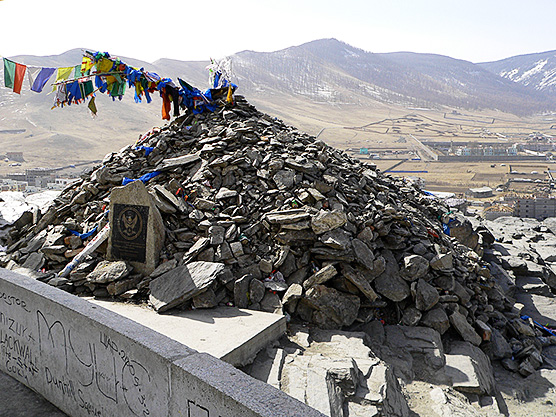
Scattered across Mongolia, the Land of the Blue Sky, you will see ovoo – small piles of rocks usually sitting high upon mountainous peaks and hilltops. Mongolian Buddhists – who make up 90% of the population – will stop at the ovoo to circle it clockwise, three times. They throw three small rocks onto the ovoo, offer thanks to the surrounding nature and seek a safe journey from their gods.
Ovoo are built on the highest peaks of land formations because Mongolians believe they are sacred sites.
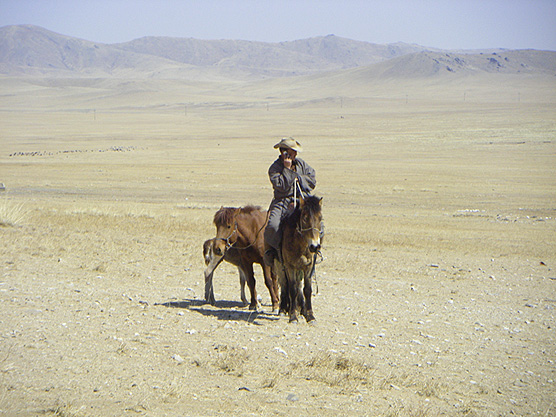
It is almost as common to see nomadic herders – dressed in traditional deel – waving their mobile phones around the ovoo, trying to catch a fleeting signal. An article in the English language daily, the UB Post in September (Mobile Phone Market Set to Boom in Mongolia, Sept. 4, 2009), says that at the end of 2008, Mongolia already had more than 1.5 million mobile phone subscribers. Mobile telecommunications is a way for nomadic dwellers to call family members in Ulaanbaatar, the capital city. Mobile phones are also a vital means of communication for nomads to access weather reports and rural market information.
Time stands still in the vast landscapes of Mongolia. This area is home to more animals than humans. It is also a place where tradition meets modern communications and there is no place the growing significance of mobile technology on people’s livelihoods is more evident. Mobile technology provides a means of communicating with the remote and disadvantaged population.
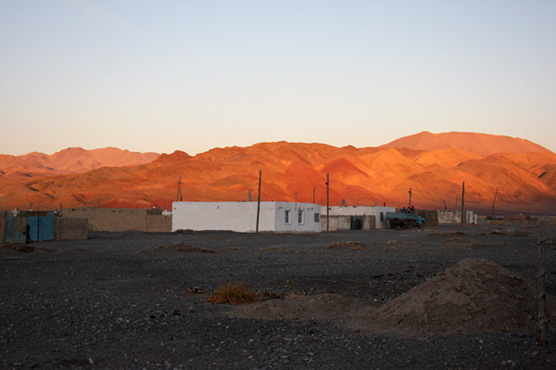
Mongolia is home to one of the largest and last surviving cultures of pastoral nomads in Central Asia. Since the fall of the Soviet Union, many Mongolians have set their eyes on Ulaanbaatar. More than half of the population now lives in the urban sprawl, drawn by consumerism and economic opportunities. This large rural migration in less than two decades has changed the shape of the rural landscape. The countryside in most parts is largely underdeveloped, lacking basic infrastructure and access to education and information. Rural herders have been left vulnerable and find themselves largely disconnected from the urban population. While the Mongolian economy still relies heavily on nomadic animal husbandry for its survival, the herders rely wholly on the land for theirs.
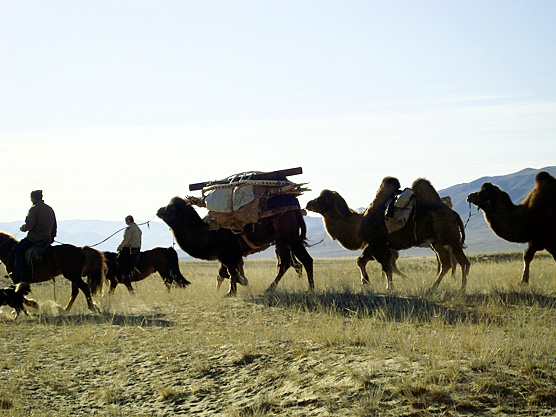
Disastrous or unpredictable weather can affect the land and threaten survival of the herders’ animals. In many cases, herders rely on weather updates on their mobile phones or messages from relatives in the city. On the steppe, they cannot effectively prepare for disastrous weather conditions by listening to or reading traditional forms of media. Timely weather updates help to decrease their vulnerability and aid their disaster management preparedness.
GlobeInternational, a local non-profit organisation based in Ulaanbaatar, and Internews, implemented a rural program called Business Roaming in 2008. It uses mobile technology to connect with remote herders and aid their participation in Mongolian economy and society. It also acts as an educational tool to assist herders in making informed decisions in a market-based economy. “Access to pertinent, high quality information, at any time and from any location, will assist rural micro-entrepreneurs in successfully organizing and diversifying their businesses and in making informed managerial decisions”, says the Internews project team in Mongolia (Internews, “ICT’s for Rural Development”).
PACT, an international development agency, has a similar project. To aid herders in making better business decisions about the sale of their agricultural produce, messages with up-to-date market information are sent to subscriber’s phones. It has market watchers that gather local prices for different commodities. Information is gathered from across the country, put into accessible data sheets and distributed weekly via sms. PACT says, “Whether considering a herd reduction to prepare for winter or facing an on-the-spot mobile commodity trader, herders can maximize profit based on factual immediately available market price information” (from PACT, “Rural Business News”). These grassroots initiatives facilitate herder’s participation in the market economy, and aid the sustainability of nomadic animal husbandry in Mongolia. Mobile technology in this instance represents an example of the “need for speed” and the significance of the dissemination of timely and up-to-date news.
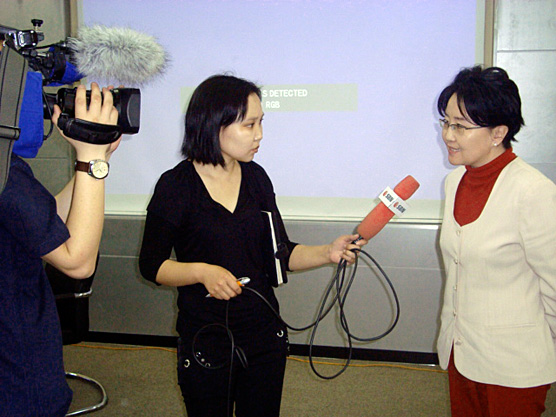
Media in Mongolia have played a vital role in the transition from a Soviet satellite state to a democracy. However, there are still various ethical and legal challenges facing journalists as they try to claim the position of public watchdog. Munkmandakh M., the director of the Press Institute a media research and training NGO in Ulaanbaatar, is familiar with problems that exist in Mongolian media (Munkhmandakh M. personal communication, November 17, 2009).
She also comes from a herder family and understands the unique challenges of communicating with nomadic families. Although she agrees mobile communication is a vital way for herders to access news and information, she said future sustainability lay in credibility. She said everyone wanted to be first to deliver news. However, in Mongolia, news is frequently copied from other sources and facts are not checked. She said the responsibility of journalism and its need to maintain credibility would be vital to maintaining herders’ access to quality, timely news. “Internet and mobile phones have the advantage to be more timely. But traditional newspapers, radio and TV have the advantage to be more responsible and provide background information”, says Munkhmandakh. The use of mobile technology can be advantageous for nomadic herders, but the quality of the news will depend on ethical considerations of journalists and producers of news.
She also warned that not all herders had access to, or the knowledge of how to use mobile phones. A 2005 UNESCO literacy country study shows a significant disparity in urban-rural education and poverty (Batchuluun Yembuu and Khulan Munkh-Erdene: 2005). Although the overall literacy rate is high – 97.8 % in 2000 – the figure is significant in terms of rural education. Mongolia is ranked 115 out of 182 countries by the latest UNDP Human Development Index report (2009).
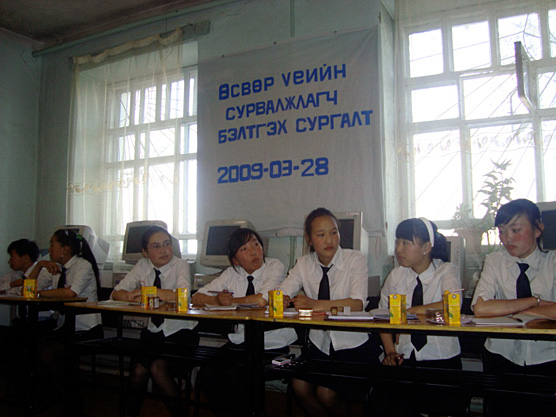
Rural areas account for 73.4% of illiterate youth. As of 2004, 83.2% of rural children left school between the ages of 8 and 15, whereas in urban areas the figure was much lower at 16.8%. International and local NGOs support a number of projects to promote literacy. In parts of the country, you can already access the internet on your mobile phone. Munkhmandakh warned however that skills-based training underpined the problem of facilitating timely news delivery to herders.
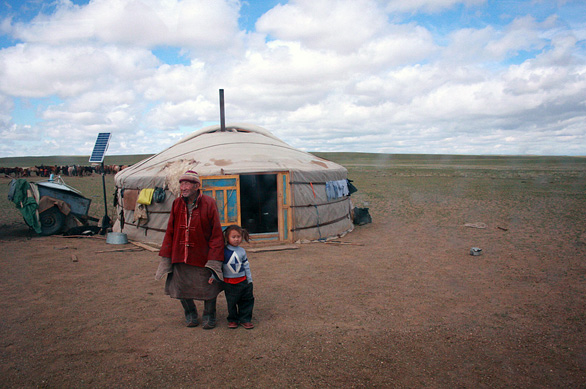
Munkhmandakh speaks passionately about climate change and the ‘desertification’ of Mongolia. In November, she was returning from Washington where the Press Institute was shortlisted as a candidate for the World Bank Global Marketplace Development Awards. The Press Institute project addresses disaster risk management in rural communities. She said that, as climate change becomes more severe, Mongolian nomads would be increasingly vulnerable. More intense natural disasters will result in more risk for nomads who live off the land. She said it was vital that Mongolian herders were included in climate change disaster plans. “Mobile phones will play a stronger role than they do now”, Munkhmandakh says.
In the future the increasing speed and access of technology in Mongolia has the potential to yield positive affects and reduce the vulnerability of nomadic herders. What will define the effect of mobile communication technologies on remote nomadic herders will be the ability of civil society, NGOs and the international community to provide quality training for receivers and producers of mobile news content.
Roman: These are captions for the photos.
PHOTO 1: An ovoo – a small pile of rocks on a hilltop or mountainous peak.
PHOTO 2: A nomadic herder in Orvokhanghai aimag on his mobile phone.
PHOTO 3: In a small soum (rural village) in Bayan Olgii aimag, far Western Mongolia – the hangover from the Soviet Union is evident.
PHOTO 4: Nomads in the Gobi desert moving to new land – the families’ ger (yurt) is on the camel.
PHOTO 5: Munkhmandakh, the director of the Press Institute being interviewed by local TV in Ulaanbaatar at a PIM roundtable discussion “Media and Transparency of Legislation in Mongolia”.
PHOTO 6: High school students in central Orvokhangai aimag, at a Journalism Club meeting. The students in the town are reporters, producers and presenters at local TV and radio stations.
PHOTO 7: A family in the Gobi desert. The child stays in the country with his grandparents, while his parents work in Ulaanbaatar.
References
Batchuluun Yembuu and Khulan Munkh-Erdene. (2005). Literacy Country Study. Education for All Global Monitoring Report 2006. Literacy for Life. Retrieved from http://unesdoc.unesco.org/images/0014/001462/146207e.pdf
Business Roaming (n.d). In Internews (Mongolia and China) Retrieved from http://www.internews.fr/spip.php?article445
Ch. Sumiyabazar. (2009, September 9). Mobile phone market set to boom in Mongolia. UB Post. Retrieved from http://ubpost.mongolnews.mn
The Human Development Index- Going Beyond Income (2009). In Human Development Reports - Mongolia. Retrieved from http://hdrstats.undp.org/en/countries/country_fact_sheets/cty_fs_MNG.html
Munkhmandakh Myagmar. personal communication, November 17, 2009
Rural Business News (n.d). In Pact World (Mongolia) Retrieved from http://www.pactworld.org/cs/mongolia/rural_busines_news
About the author
Kitty Hamilton is a journalist. She spent 12 months in Mongolia as part of the Australian Youth Ambassador’s for Development program. She worked at the Press Institute as a journalism trainer. She also worked on projects including Improving Political Reporting, Video Conferencing in East Asia Pacific, Press Freedom in Mongolia, and other media advocacy campaigns. She now works in Xinhua news agency, Beijing.
Contact Details
Email: hamiltonkitty@gmail.com